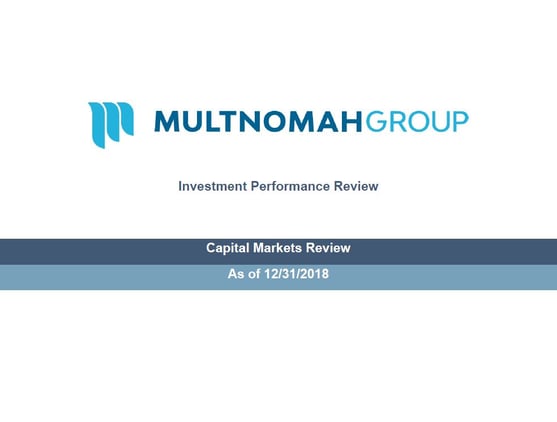 The U.S. economic expansion continues, but slower growth is coming. Real GDP grew at an annual rate of 3.4% (quarter over quarter) for the third quarter of 2018 - the most recent data available. The current economic expansion is in its 10th year – the second longest expansion in U.S. history. There are definite signs that economic growth is slowing with weakness in housing, deterioration in the trade deficit, and lower business spending. Core CPI, which strips out food and energy prices, dipped in December, its first drop in nine months mainly due to lower gasoline prices. Core CPI remains substantially beneath the 50-year average of 4.0%.
The U.S. economic expansion continues, but slower growth is coming. Real GDP grew at an annual rate of 3.4% (quarter over quarter) for the third quarter of 2018 - the most recent data available. The current economic expansion is in its 10th year – the second longest expansion in U.S. history. There are definite signs that economic growth is slowing with weakness in housing, deterioration in the trade deficit, and lower business spending. Core CPI, which strips out food and energy prices, dipped in December, its first drop in nine months mainly due to lower gasoline prices. Core CPI remains substantially beneath the 50-year average of 4.0%.
The labor market remains robust. The unemployment rate crept up to 3.9% in December, from 3.7% in November, which was the lowest level since 1969. In December, 312,000 jobs were created which exceeded economists’ expectations. Consumer spending, which makes up over two-thirds of the economy, reported a solid gain of 0.4% in November. U.S. manufacturing activity slipped in December with the ISM manufacturing index falling to its lowest level since November 2016.
The Federal Reserve (Fed) is downshifting its expectations as it dialed back its rate-hike projections and economic growth forecast for 2019. The Fed raised interest rates again in December 2018 by a quarter point; the recent rate hike was the fourth rate hike in 2018 and the ninth rate increase since December 2015. As expected, the Fed upped the mid-point of the fed funds target range by 25 basis points, to 2.375%.
Despite the rate hikes in 2018, long-term rates have not kept pace causing the yield curve to continue to flatten through year-end. The 2-, 10-, and 30-year Treasury bond yields declined to 2.48%, 2.69%, and 3.02% for the quarter, respectively. The top fixed-income performers for the quarter were U.S. Treasuries (up 2.6%) and mortgage-backed securities (up 2.1%). High yield bonds and emerging market bonds were the worst fixed income performers declining 4.4% and 1.2%, respectively. The U.S. dollar rallied against the Canadian and the Australian dollar during the quarter. The dollar was strong versus most major currencies for the year.
The U.S. equity markets took a beating in late 2018. The S&P 500 dropped 13.5% in the fourth quarter; the move was broad-based as all sectors except for utilities ended the quarter lower. The majority of the decline came in December. For the full year, the S&P 500 declined 4.4% - its worst year in a decade. The markets have been spooked by a laundry list of items that include slowing economic growth, questions about the Fed's monetary policies, rising national and corporate debt, trade negotiations with China, and Brexit uncertainty. Energy, technology, and industrial sectors showed the largest declines during the quarter, falling by 23.8%, 17.3%, and 17.3% respectively. The forward P/E for the S&P 500 decreased to 14.4x for Q4, dropping below the 25-year average of 16.1x. The CBOE Volatility Index (VIX Index) ended the year with volatility surging in the fourth quarter.
International equities also felt the pain in the quarter. Emerging markets equities declined less than Developed Europe and Developed Asia in the fourth quarter; all three international markets had large declines in 2018 as the stronger dollar has been a headwind for performance. Developed Europe (ex-UK) and Developed Asia reported losses of 13.0% and 12.2% in Q4, respectively. Emerging markets equities declined 7.4% in Q4; EM Asia was the worst hit (down 9.2%) while Latin America reported a slight gain for the quarter.
On the commodities front, the Bloomberg Commodity Index declined by 10% for the quarter, led by a large decline in oil prices. The price of U.S. crude oil (West Texas Intermediate) dropped nearly 40% in the final quarter of 2018, ending the year at $45.33 per barrel. Oil prices were impacted by increased oil production by the top three producers (U.S., Russia, and Saudi Arabia) and rising inventories. Crude oil prices were rising for most of 2018 given the increased potential for supply constraints and declining global petroleum inventories.
REITs tumbled during the quarter, ending the year with a loss of 5.8%. The housing market is under pressure given higher mortgage rates and home prices along with increased economic uncertainty and stock market volatility. Mortgage rates retreated a bit in December and into January, after topping 5.0% for a 30-year fixed rate mortgage.
Multnomah Group is a registered investment adviser, registered with the Securities and Exchange Commission. Any information contained herein or on Multnomah Group’s website is provided for educational purposes only and does not intend to make an offer or solicitation for the sale or purchase of any specific securities, investments, or investment strategies. Investments involve risk and, unless otherwise stated, are not guaranteed. Multnomah Group does not provide legal or tax advice. Any views expressed herein are those of the author(s) and not necessarily those of Multnomah Group or Multnomah Group’s clients.


